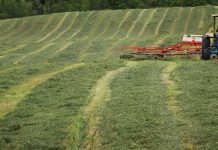Where you farm is important. Different soil types, climate and topography have a big impact on what you grow, how you grow and the base level of fertility present.
Only 3 percent of the surface of the earth is considered prime farmland, suitable for intense cultivation.
The actions of glacial migration had a tremendous impact on what soil types are present in different locations, especially in Ohio. Hocking County, where I work, is located in the southeastern portion of Ohio at the far edge of where the glacial migration ended. Only a tiny portion of the westernmost edge was touched by glaciers. It lies in the unglaciated region of the Appalachian Plateau, and didn’t receive the rich agricultural deposits the glaciers brought with them.
While the state of Ohio has over 450 different soil types, with Hocking County alone having dozens of them, only 15 percent of the county is designated as prime farmland, primarily in waterway floodplains.
The rest of Hocking County is characterized by sandy soils that have thin topsoil layers with steep topography. That is why we mostly have trees, with their deep and extensive root systems and grasses that can hold onto the soil.
SE Ohio soil data
Most of the data and teaching that we Extension Agriculture and Natural Resources educators receive at our yearly fertilizer applicator certification trainings contain information sourced from research done to combat nutrient runoff in the western Lake Erie basin. So this past spring, I decided to build a presentation using data sourced from local producers to provide a more accurate picture of the fertilization challenges of the Appalachian Plateau soil region.
I collected 15 soil samples from pasture or hay ground from Hocking County producers. Soil testing was done by Spectrum Analytic with S1 testing results, including soil pH, buffer pH, organic matter, available phosphorus, exchangeable potassium, magnesium, calcium and cation exchange capacity (CEC).
I organized the results into bar graphs to present as part of the fertilizer certification training.
Read your results
Soil testing is one of the best, least expensive tools a producer can use to maximize profit. The local results showed that many, if not most, of the farms needed to adjust pH through liming, as well as increase their fertilization plans. They were missing out on potential forage gains due to decreased fertility in critical nutrients and a pH that did not support vigorous plant growth.
The average pH of the samples was 5.9, with the lowest value being 5.2. This is very common in our region. Grasses grow best at a pH greater than 6.0 and legumes like the pH above 6.5. This low pH did not allow the preferred forages to compete equally with the weeds, decreasing yield and forage quality.
Phosphorus was also reliably low across the board. While levels of phosphorus are quite high in northwestern Ohio, the average value from my samples was 19 part per million (ppm). This value was elevated from two high samples, however, as 12 of the 15 submitted samples had phosphorus levels of 15 ppm or less. Optimal range for grass and legume seeding per Spectrum Analytic is 50 to 70 ppm.
Phosphorus is one of the three major plant nutrients contributing to overall plant health and strong root growth. These low levels could decrease forage gains and allow weeds to out-compete the preferred forages as well.
As a soil scientist, I make a pretty good veterinarian. Any mistakes I made interpreting these tests are mine alone and I recognize that this is not completely scientific. My goal was to make the applicator training pertinent to the producers in my county and region and I think if other producers in the Appalachian Plateau looked at their soil test results, they may find similar results.
The good news is that soil testing is easy, inexpensive and it can point out ways that producers can potentially increase yield as well as profit in their pasture and hay ground.
Where you farm says a lot about what you can grow. Make sure you know your soils so that you can maximize your production and profits.













